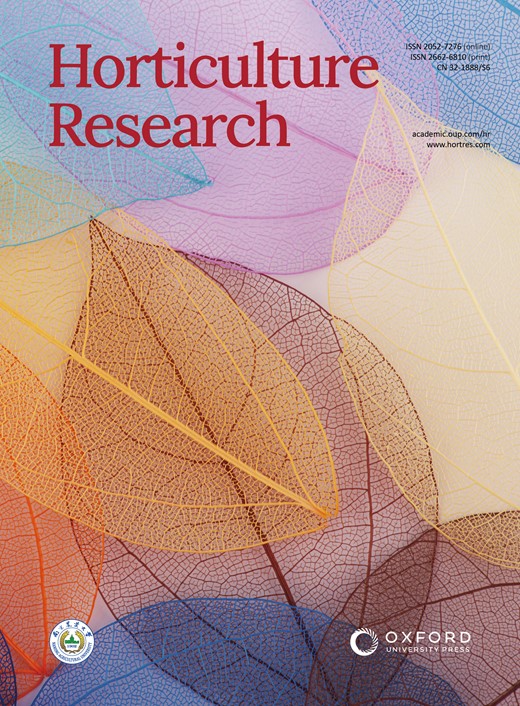ApWRKY26/ApERF4-ApMYB2模块调控掌叶槭花青素积累,促进叶片颜色的季节性转变
IF 8.5
1区 农林科学
Q1 Agricultural and Biological Sciences
引用次数: 0
摘要
棕榈槭‘朵彩’是一种通过无性繁殖维持的优良观赏品种。在春天和秋天,它长出红叶,在夏天,它长出绿叶。为了研究这些季节性色素沉着变化背后的遗传和表观遗传调控,我们实施了一项全面的多组学方法。代谢组学分析鉴定花青素-3- o -葡萄糖苷是控制季节性叶片颜色变化的主要生化因子。利用RNA-seq、ATAC-seq、Hi-C和WGBS检测转录组学和染色质重塑动力学。多组学调控网络分析发现ApMYB2是通过调控ApF3'H2表达影响花青素积累的关键转录因子。功能分析表明,转录因子ApWRKY26正向调节ApMYB2的表达,而ApERF4对其表达有抑制作用。基于季节性rna序列的相关分析证实了这些调控相互作用。遗传操作实验,包括这些基因在棕榈中的过表达和沉默,提供了经验证据支持它们在花青素生物合成途径中的功能作用。总之,我们的研究阐明了ApWRKY26和ApERF4通过协调ApMYB2的活性来控制棕榈叶片季节性花青素合成的分子机制。本文章由计算机程序翻译,如有差异,请以英文原文为准。
The ApWRKY26/ApERF4-ApMYB2 module regulates anthocyanin accumulation for the seasonal leaf color transition in Acer palmatum
Acer palmatum 'Duocai' is an excellent ornamental cultivar maintained through asexual propagation. In spring and autumn, it exhibits red leaves, and in summer, it displays green leaves. To investigate the genetic and epigenetic regulation underlying these seasonal pigmentation shifts, we implemented a comprehensive multi-omics approach. Metabolomic profiling identified cyanidin-3-O-glucoside as the predominant biochemical factor governing seasonal leaf color transitions. RNA-seq, ATAC-seq, Hi-C, and WGBS were utilized to examine transcriptomic and chromatin remodeling dynamics. Multi-omics regulatory network analysis identified ApMYB2 as a key transcription factor affecting anthocyanin accumulation by regulating ApF3'H2 expression. Functional analyses demonstrated that the transcription factor ApWRKY26 positively modulates ApMYB2 expression, while ApERF4 exerts an inhibitory effect on its expression. These regulatory interactions were corroborated by seasonal RNA-seq-based correlation analyses. Genetic manipulation experiments, including overexpression and silencing of these genes in A. palmatum, provided empirical evidence supporting their functional roles in the anthocyanin biosynthetic pathway. Together, our study elucidates the molecular mechanism by which ApWRKY26 and ApERF4 coordinate the activity of ApMYB2 to govern seasonal anthocyanin synthesis in A. palmatum foliage.
求助全文
通过发布文献求助,成功后即可免费获取论文全文。
去求助
来源期刊

Horticulture Research
Biochemistry, Genetics and Molecular Biology-Biochemistry
CiteScore
11.20
自引率
6.90%
发文量
367
审稿时长
20 weeks
期刊介绍:
Horticulture Research, an open access journal affiliated with Nanjing Agricultural University, has achieved the prestigious ranking of number one in the Horticulture category of the Journal Citation Reports ™ from Clarivate, 2022. As a leading publication in the field, the journal is dedicated to disseminating original research articles, comprehensive reviews, insightful perspectives, thought-provoking comments, and valuable correspondence articles and letters to the editor. Its scope encompasses all vital aspects of horticultural plants and disciplines, such as biotechnology, breeding, cellular and molecular biology, evolution, genetics, inter-species interactions, physiology, and the origination and domestication of crops.
 求助内容:
求助内容: 应助结果提醒方式:
应助结果提醒方式:


